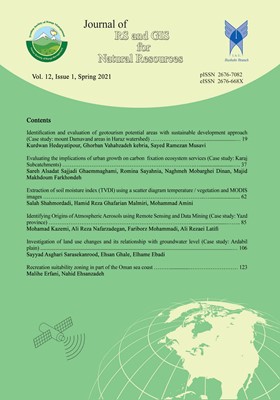-
-
List of Articles
-
Open Access Article
1 - Identification and evaluation of geotourism potential areas with sustainable development approach (Case study: mount Damavand areas in Haraz watershed)
Kurdwan Hedayatipour Ghorban Vahabzadeh kebria Sayed Ramezan Musavi -
Open Access Article
2 - Evaluating the implications of urban growth on carbon fixation ecosystem services (Case study: Karaj Subcatchments)
Sareh Alsadat Sajjadi Ghaemmaghami Romina Sayahnia Naghmeh Mobarghei Dinan Majid Makhdoum Farkhondeh -
Open Access Article
3 - Extraction of soil moisture index (TVDI) using a scatter diagram temperature/vegetation and MODIS images
Salah Shahmoradi Hamid Reza Ghafarian Malamiri Mohammad Amini -
Open Access Article
4 - Identifying Origins of Atmospheric Aerosols using Remote Sensing and Data Mining (Case study: Yazd province)
Mohamad Kazemi Ali Reza Nafarzadegan Fariborz Mohammadi Ali Rezaei Latifi -
Open Access Article
5 - Investigation of land use changes and its relationship with groundwater level (Case study: Ardabil plain)
Sayyad Asghari Saraskanroud Ehsan Ghale Elhameh Ebady -
Open Access Article
6 - Recreation suitability zoning in part of the Oman sea coast
Malihe Erfani Nahid EhsanZadeh
-
The rights to this website are owned by the Raimag Press Management System.
Copyright © 2021-2025







